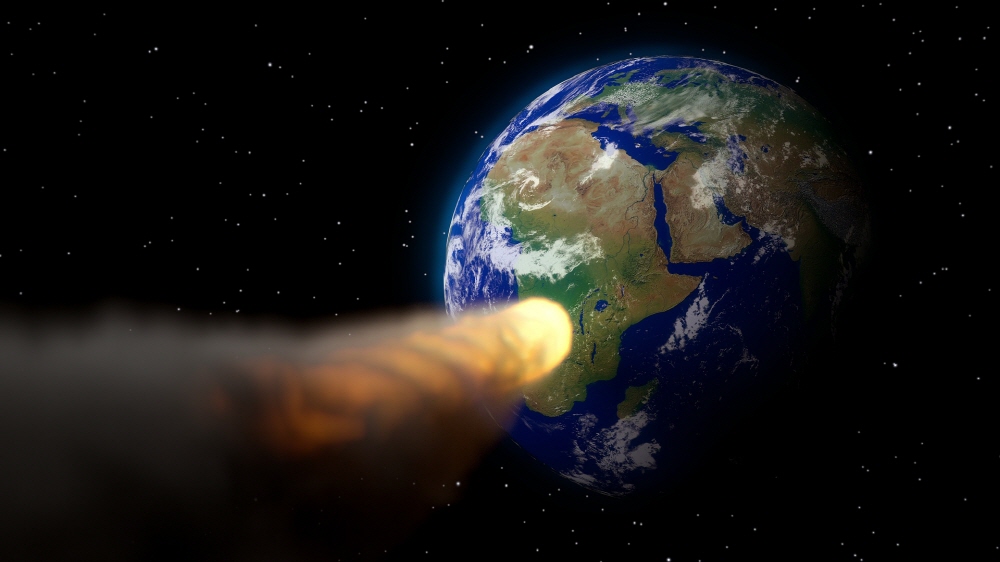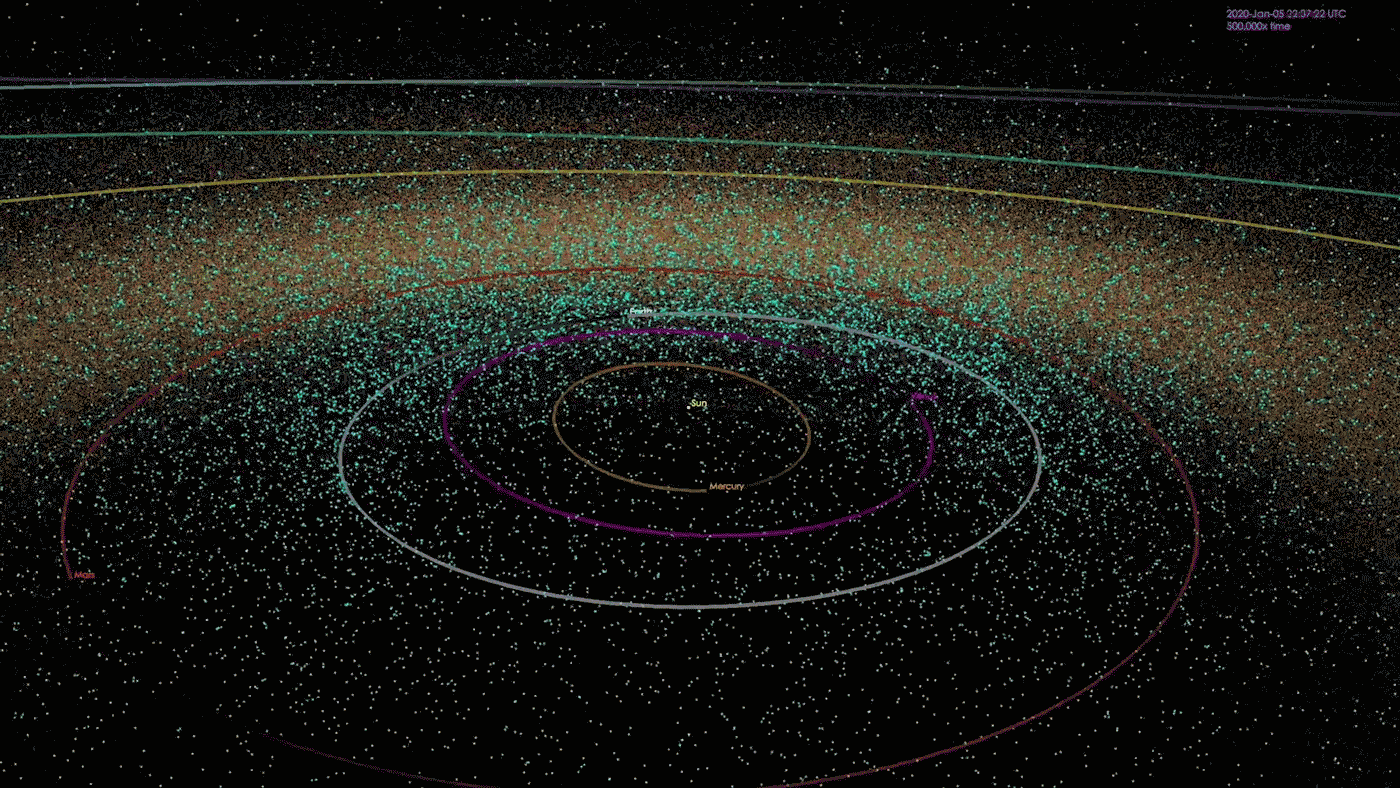
On July 25, it was revealed that the Earth and asteroids had an abnormal approach. The sudden appearance of the asteroid 2019 OK is 57-130m in diameter and has a unique shape. This asteroid reached Earth 73,000 kilometers from Earth, a fifth of its distance from the Moon. Experts say that if it had landed on Earth, it would have destroyed the whole city more powerfully than a huge atomic bomb.
What made the 2019 OK’s approach unpredictable is the small size of the asteroid and its extreme elliptical orbit.
This is the video of the close encounter of Asteroid 2019 OK we have been Twitting all day with the Earth: https://t.co/bjT7uhQJuO pic.twitter.com/3e4UyPcdPl
— ASAS-SN (@SuperASASSN) July 25, 2019
https://platform.twitter.com/widgets.js
Of course, experts say there will be no asteroids that are likely to cause catastrophe on Earth for hundreds of years. Conversely, it is true that a small asteroid called the 2008 ST has approached more than 2014, and it is also unpredictable when a threat like 2019 OK will pass overhead. For this reason, scientists around the world take the asteroid threat seriously. At the beginning of this year, NASA and the Federal Emergency Management Agency (FEMA) jointly conducted rehearsal exercises that assumed an asteroid impact on Earth.
The solar system was formed from the dust surrounding the primitive sun. Most of the dust became planets, including Earth, but the rest gradually formed asteroids as they collided with each other. There are numerous asteroid belts between Mars and Jupiter, but this is because Jupiter’s strong gravity inhibited the formation of the planet. In addition, these asteroids sometimes interfere with the orbit and approach Earth by the gravity of Jupiter.

In addition to asteroids, objects such as comets can also approach Earth. These asteroids and comets are called near-earth objects (NEOs). The NEO also includes asteroids within 1.3 astronomical units of the Sun and comets orbiting the Sun within 200 years. One astronomical unit refers to the average distance between the earth and the sun, 150 million kilometers.
Scientists classify NEOs as potentially hazardous asteroids (PHAs) that have a high potential to pose a risk to Earth. It means having an orbit that crosses the Earth’s orbit with a diameter of 140m or more and approaches within 0.5 astronomical units from Earth, so within 20 times the average distance of the Moon from Earth.
If PHAs fall on the earth, they will cause enormous damage to the area, and the disaster caused by the fall of a meteorite will be a combination of earthquakes, tsunamis, heat waves, and shock waves. Astronomer Edmund Halley had already pointed out the possibility of a comet falling to Earth in 1694.
And in 1908, the Tunguska incident took place. A meteorite that fell over the Tungusta River in Russia exploded in the atmosphere, destroying the forest in an instant. Subsequently, the asteroid Hermes passing near the Earth was observed, and in the 1930s many large asteroids were discovered, gradually increasing anxiety.
In 1980, an asteroid impact theory was born when strata, including iridium, were discovered 65 million years ago on the bottom of the Gulf of Mexico. Based on this discovery, the rumor of the extinction of dinosaurs by meteorites came out and is now becoming the norm.
However, the biggest meteorite fall in modern times occurred on Jupiter, not Earth. Comet Shoemaker–Levy 9 orbiting Jupiter was discovered in 1993 and quickly gained attention. The analysis revealed that the orbit collides with Jupiter. In fact, 25 years ago, in July 1994, comet Shoemaker-Levy 9 struck Jupiter. A few months’ mark on Jupiter’s surface vividly indicates the intensity of the impact. The colliding of comet Shoemaker-Levy 9 was a huge shock. This is because if an asteroid hits Jupiter, it is quite possible that an asteroid hits Earth.
Experts say it is clear that Earth has suffered a meteorite impact in the past, as evidenced by the crater in Arizona. However, the Shoemaker-Levy 9 comet collision taught us that even at this moment, it is not at all strange if a meteorite hits the Earth.
The Shoemaker-Levy 9 Comet Collision and Lewis Alvarez’s theory of asteroid collision were gradually gaining recognition, and it was in the 1990s that the US Congress began taking measures against meteorites. In 1992, it commissioned the launch of the NASA asteroid observation program, and in 1998 requested that all asteroids with a diameter of over 1 km, including NEO, be listed within 10 years. The NEO observation program, which was born that year, will be installed at the NASA Jet Propulsion Laboratory JLP. Following this, the Earth Approaching Astrophysical Research Center has been renamed CNEOS (Center for NEO Studies).
In 2005, Congress sets more ambitious goals. It plans to list 90% of NEOs over 140m in diameter by 2020 and is still in progress.
Projects to protect the planet from asteroid threats have spent millions of dollars in budget and are growing on an international scale. In the case of the United States, NASA is in charge of searching for new asteroids and sharing the information with the government, the media, and the public in the event of an emergency. Research on how to prevent impact or how to deal with when meteorites are likely to collide with the Earth. In addition, space agencies around the world, such as ESA in Europe and Roscosmos in Russia, are operating NEO observation research projects.
NASA primarily searches for asteroids using an astronomical satellite called the Wide-field Infrared Survey Explorer (WISE). In addition, IRTF, an infrared telescope facility installed in Hawaii, is responsible for analyzing the recently discovered NEO. When a new NEO is discovered, the characteristics of the asteroid are converted into data, shared with the Earth Approaching Astronomical Research Center, and the period and orbit are calculated. Similar attempts are being made in institutions around the world.
As a result of these efforts, there are no asteroids currently known to threaten Earth. Analysis results show that none of the asteroids in the database of the Earth Approach Astrophysical Research Center will collide with Earth for the next 188 years.
But what you really need to worry about is that there are many asteroids that have not been registered and have not even been discovered. Despite the desperate efforts of each country, it is said that only a third of the NEOs known to be 25,000 have yet to be registered. There are various reasons, but one of the reasons is the lack of installation investment. Another of the most annoying is a small asteroid less than 140 m in diameter. 2019 OK, which passed the Earth in July, also falls into this category.
These small meteorites are difficult to detect and may not even exist until just before impact, but they are a threat with considerable destructive power. In fact, a meteorite with a diameter of 20 meters, which fell in Chelyabinsk, Russia in 2013, exploded in the air, similar to Tunguska, injuring 1,491 people. Recently, there was also a meteorite that exploded in the air in the Bering Sea in December 2018. This meteorite is less than 140m, which was set by the US Congress as a search range, but it has sufficient disaster risk.
In fact, harmless asteroids the size of a grain of sand are constantly colliding with the Earth, but they burn as they pass through the atmosphere and do not damage the ground. According to research, the probability of a 1m diameter asteroid colliding with the Earth is about once a year, a 100m diameter asteroid once every 10,000 years, a 1,000m diameter asteroid once every 1 million years, etc. The probability is said to decrease.
But experts say there is a good chance that a cellabinsk-class meteorite will fall alive. There are only a few meteorite collisions, but natural disasters such as typhoons and floods occur in many parts of the world every year. Of course, even if a meteorite has approached Earth, there is a possibility that it will be sufficiently avoided with time. NASA’s OSIRIS-REx mission continues to be observed in orbit around the asteroid Bennu, which could hit Earth for hundreds of years. In 2021, the probe DART (Double Asteroid Redirection Test) mission is also launched. In this mission, a bold experiment is conducted to change the orbit of the asteroid by colliding the body with the asteroid Didimos at 6 km/sec. If this experiment succeeds, it may be possible in the future to change the orbit of asteroids approaching Earth with similar technologies.
Asteroid impact is a unlikely, but not negligible threat. Even at this moment, the Earth Defense operation continues to protect the Earth from asteroids.



